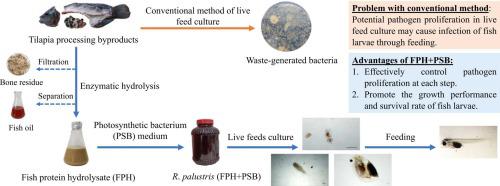Aquaculture Reports ( IF 3.2 ) Pub Date : 2022-12-16 , DOI: 10.1016/j.aqrep.2022.101439 I-Pei Kuo , Ching-Shuo Liu , Shuenn-Der Yang , Zhen-Hao Liao , Yeh-Fang Hu , Fan-Hua Nan

|
Fish processing byproducts are conventionally used in live feed production for larviculture because of their low cost and high productivity. However, waste-generated bacteria may cause pathogen proliferation, and antibiotics are widely used to reduce the bacterial loads of live feeds. In this study, tilapia processing byproducts were hydrolyzed into fish protein hydrolysate (FPH). Subsequently, the FPH was used to culture Rhodopseudomonas palustris, a photosynthetic bacterium (PSB), as a nutritional source for live feed. The results of the in vitro pathogen inhibition assay indicated that R. palustris significantly inhibited the growth of Aeromonas hydrophila, Edwardsiella tarda, Lactococcus garviae, and Streptococcus iniae in the FPH supernatant (p < 0.05). In practical live feed culture, untreated minced tilapia byproduct (control group) or FPH+PSB were used as nutritional sources for the live feeds. The V3–V4 region of the 16 S rRNA gene was amplified and sequenced for microbiota analysis. In the FPH+PSB group, Flavobacteriaceae and Alteromonadaceae were notably enriched. The Aeromonadaceae and Chitinophagaceae were reduced relative to the control group. Burkholdweiaceae, Rhodobacteraceae, Moraxellaceae, and Pseudomonadaceae were the dominant bacterial families in both groups. To examine the effects of different live feed culturing methods on larviculture, the cultured live feed was fed to Bidyanus bidyanus larvae at 5 days posthatch (DPH). After 25 days of larviculture, the growth performance and survival rate of the FPH+PSB group were significantly higher than those of the control group (p < 0.05). These results indicated that treating tilapia byproducts with hydrolysis and R. palustris to culture live feed exerted a positive effect on B. bidyanus larviculture.
中文翻译:

经酶水解和沼泽红假单胞菌处理的罗非鱼加工副产物可用于活饲料养殖:体外病原体抑制、活饲料微生物群和 Bidyanus bidyanus 幼体养殖
鱼类加工副产品通常用于幼虫养殖的活饲料生产,因为它们成本低、生产率高。然而,废物产生的细菌可能会导致病原体增殖,抗生素被广泛用于减少活饲料的细菌负荷。在这项研究中,罗非鱼加工副产品被水解成鱼蛋白水解物 (FPH)。随后,FPH 被用于培养沼泽红假单胞菌( Rhodopseudomonas palustris),一种光合细菌 (PSB),作为活饲料的营养来源。体外病原体抑制试验的结果表明,R。沼泽藻显着抑制嗜水气单胞菌、迟缓爱德华氏菌、FPH 上清液中的加氏乳球菌和海豚链球菌( p < 0.05)。在实际的活饲料培养中,未处理的罗非鱼碎副产品(对照组)或 FPH+PSB 被用作活饲料的营养来源。16S rRNA 基因的 V3-V4 区域被扩增并测序用于微生物群分析。在FPH+PSB组中,黄杆菌科和交替单胞菌科显着富集。气单胞菌科和几丁质菌科相对于对照组减少。Burkholdweiaceae、Rhodobacteraceae、Moraxellaceae 和 Pseudomonadaceae 是两组中的优势菌科。为了研究不同活饲料养殖方法对幼体养殖的影响,将养殖的活饲料喂给比迪亚努斯孵化后 5 天的幼虫 (DPH)。幼体培养25 d后,FPH+PSB组的生长性能和成活率均显着高于对照组(p < 0.05)。这些结果表明,用水解和R处理罗非鱼副产物。沼泽养殖活饲料对B产生了积极影响。bidyanus幼体养殖。





















































 京公网安备 11010802027423号
京公网安备 11010802027423号